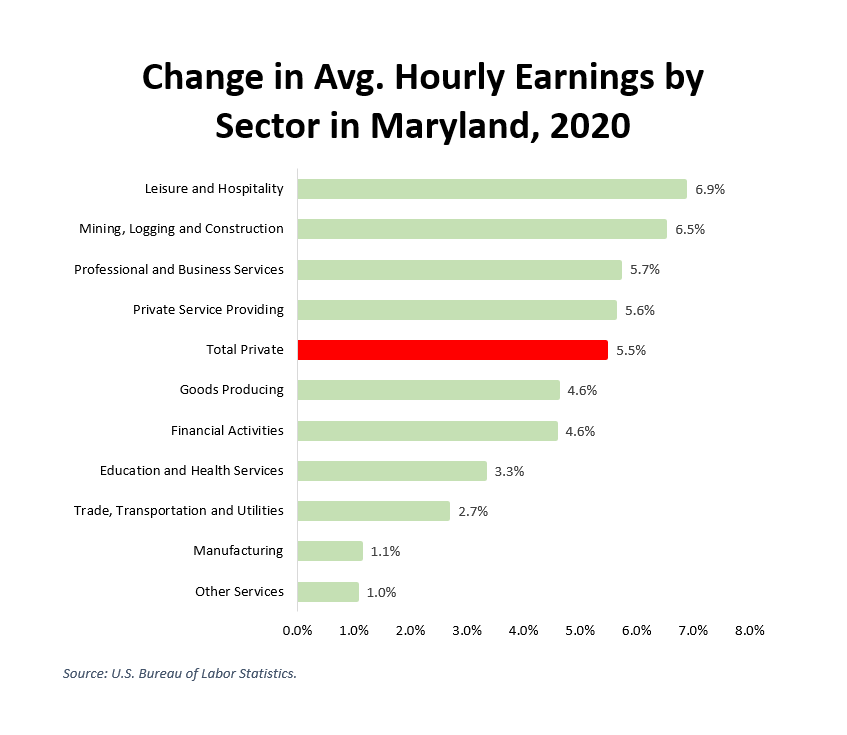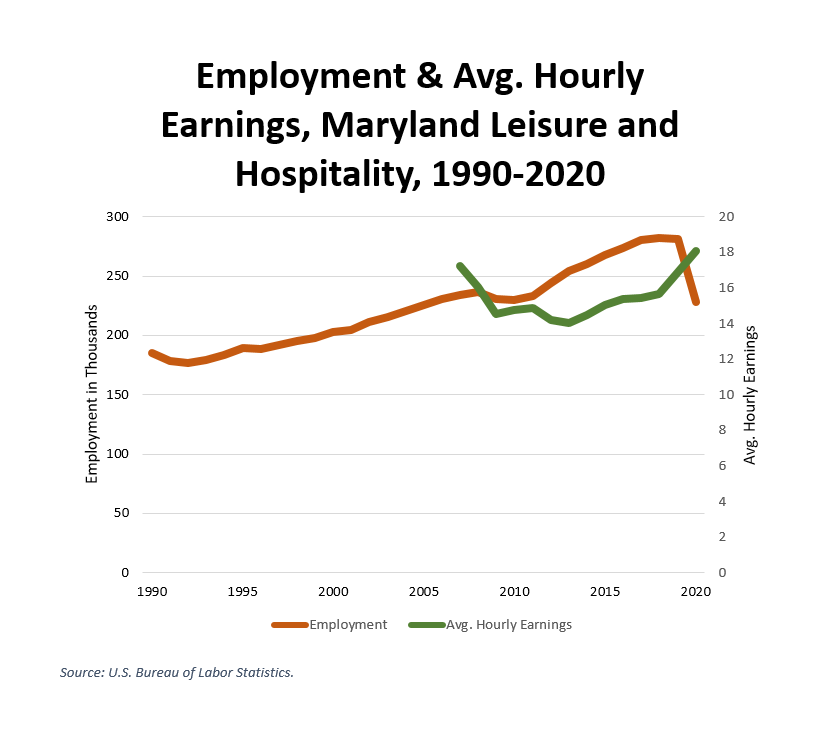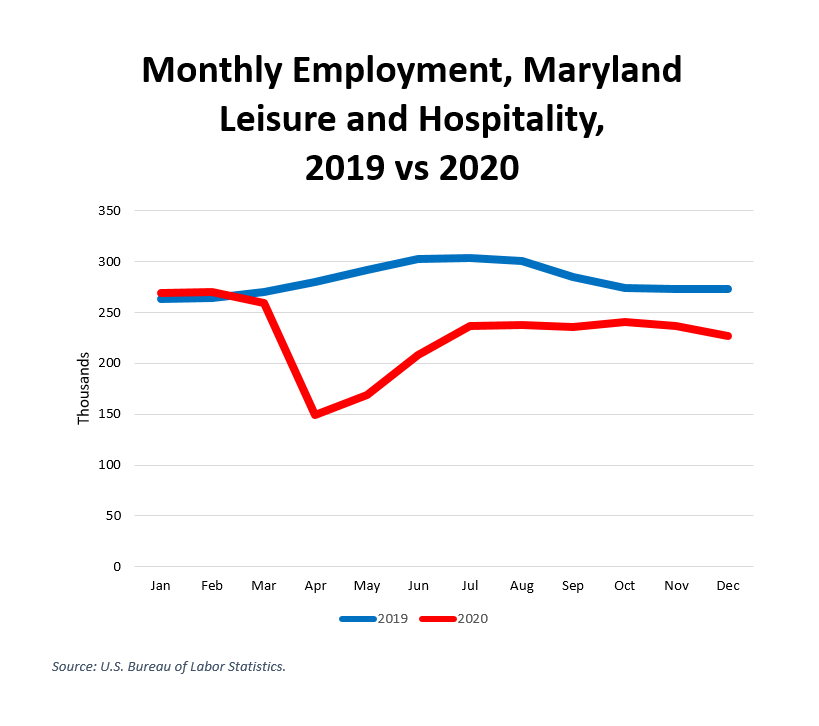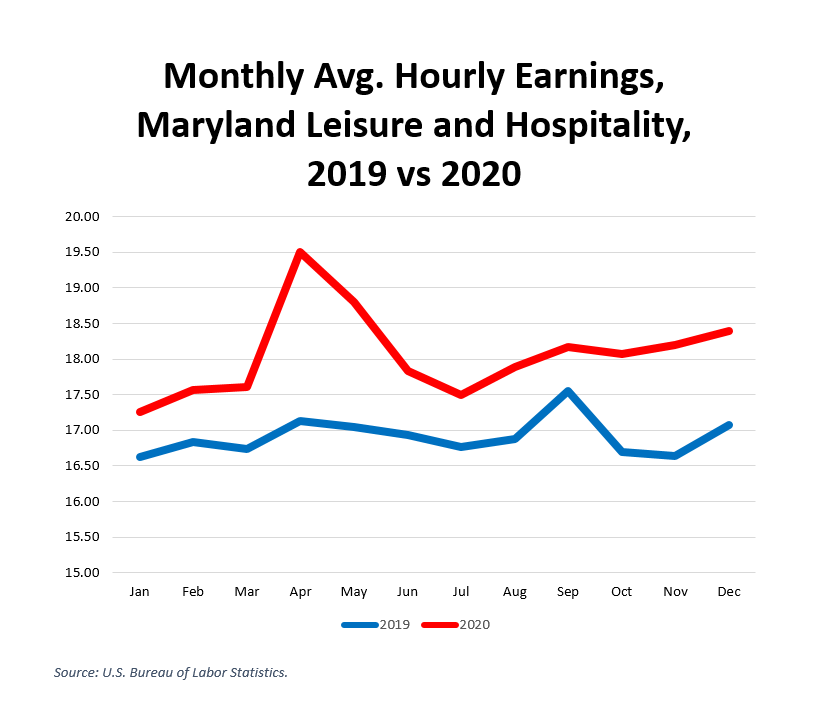By Adam Pagnucco.
In Part Two, we identified one reason why average wages have been rising during the COVID recession: job losses have been concentrated in the leisure and hospitality sector. Since that sector pays low wages, disproportionate job losses there tend to push average wage rates up.
But that’s not all that is going on.
The chart below shows changes in average hourly earnings by sector in Maryland. Most sectors are seeing substantial increases, with some beating the 1.4% change in the consumer price index in 2020 by several multiples.

The craziest finding in that chart is that leisure and hospitality, which had by far the biggest job loss in 2020, also had the largest increase in average hourly earnings. That violates every lesson in supply and demand taught in Economics 101. An industry with precipitous job losses should have a big drop in wages. Why is the opposite happening?
Let’s take a closer look at Maryland’s leisure and hospitality sector. The chart below shows employment (on the left axis) and average hourly earnings (on the right axis) in leisure and hospitality since 1990. (Average hourly earnings are only available starting in 2007.) For the most part, this is what we would expect to see. Employment has grown with interruptions in the early 1990s recession, the Great Recession and the COVID recession. Average hourly earnings fell during the Great Recession and recovered afterwards. So far, so good.

Now let’s zero in on the last two years. The chart below shows the monthly employment in the sector for both 2019 and 2020. (Data for December 2020 is preliminary.)

In the first two months of 2020, Maryland’s leisure and hospitality sector was on pace to have 2-3% more jobs than in 2019. Then the pandemic hit and in April 2020, employment was 47% less than in April 2019. The sector recovered somewhat though it did not enjoy the summer bump that it normally gets. By November and December, when COVID case rates began to rise again, the sector began losing jobs again. Overall, its employment in 2020 seems tied to public health restrictions and consumer behavior tied to the virus.
Now let’s look at monthly average hourly earnings in the sector in 2019 and 2020.

The massive job loss in April coincided with a massive spike in average hourly earnings. The smaller job loss in the last two months of the year coincided with a smaller spike in average hourly earnings. At first glance, this doesn’t seem to make much sense if you remember supply and demand from Economics 101.
But it might make sense depending on who gets laid off. The leisure and hospitality sector, like other sectors, has wide variations between employees in skill, seniority and responsibility – all of which tend to be associated with pay differentials. What if the workers who were laid off in April and in the winter were disproportionately low tenure, less skilled and non-supervisory? And what if the workers who were protected were disproportionately highly skilled, high tenure, supervisory and critical to their employers? That would explain the pattern in leisure and hospitality and in the other sectors too: job losses coincide with average hourly earnings spikes because lower paid workers are the ones being let go, thus skewing the wage distribution upwards.
This coincides with findings cited by the U.S. Bureau of Labor Statistics that job losses have been “strongly concentrated among low-wage workers,” including hospitality workers, young workers, less educated workers and part-time workers. One article finds that “the pandemic’s negative economic effects are most severe and likely to be longest lasting for low-paid workers in more affluent locations.” That’s a good description of the realities faced by many recession-impacted workers in Maryland, who are hit both by job losses and high costs of living. Think of how this applies to a laid-off restaurant employee in Montgomery, Howard or Anne Arundel counties.
If this theory is true, then the rising average wages during the COVID recession are not a sign of prosperity – they’re a sign of rampant, increasing income inequality. In Part Four, we will see how this is playing out in some locations in Maryland.
